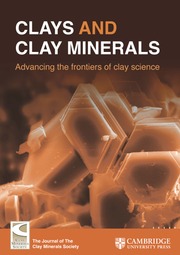Crossref Citations
This article has been cited by the following publications. This list is generated based on data provided by
Crossref.
MERRIMAN, R. J.
ROBERTS, B.
PEACOR, D. R.
and
HIRONS, S. R.
1995.
Strain‐related differences in the crystal growth of white mica and chlorite: a TEM and XRD study of the development of metapelitic microfabrics in the Southern Uplands thrust terrane, Scotland.
Journal of Metamorphic Geology,
Vol. 13,
Issue. 5,
p.
559.
Essene, E. J.
and
Peacor, D. R.
1995.
Clay Mineral Thermometry—A Critical Perspective.
Clays and Clay Minerals,
Vol. 43,
Issue. 5,
p.
540.
Li, Gejing
Peacor, D. R.
Coombs, D. S.
and
Kawachi, Y.
1996.
TEM/AEM characterization of fine-grained clay minerals in very-low-grade rocks: Evaluation of contamination by empa involving celadonite family minerals.
Proceedings, annual meeting, Electron Microscopy Society of America,
Vol. 54,
Issue. ,
p.
694.
KNUDSEN, T.‐L.
1996.
Petrology and geothermobarometry of granulite facies metapelites from the Hisøy‐Torungen area, south Norway: new data on the Sveconorvegian P–T–t path of the Bamble sector.
Journal of Metamorphic Geology,
Vol. 14,
Issue. 3,
p.
267.
Nieto, F.
Ortega-Huertas, M.
Peacor, D. R.
and
Arostegui, J.
1996.
Evolution of Illite/Smectite from Early Diagenesis Through Incipient Metamorphism in Sediments of the Basque-Cantabrian Basin.
Clays and Clay Minerals,
Vol. 44,
Issue. 3,
p.
304.
Ryan, P. C.
and
Reynolds, R. C.
1997.
The Chemical Composition of Serpentine/Chlorite in the Tuscaloosa Formation, United States Gulf Coast: EDX vs. XRD Determinations, Implications for Mineralogic Reactions and the Origin of Anatase.
Clays and Clay Minerals,
Vol. 45,
Issue. 3,
p.
339.
Garvie, L. A. J.
and
Metcalfe, R.
1997.
A vein occurrence of co-existing talc, saponite, and corrensite, Builth Wells, Wales.
Clay Minerals,
Vol. 32,
Issue. 2,
p.
223.
Árkai, P.
and
Sadek Ghabrial, D.
1997.
Chlorite crystallinity as an indicator of metamorphic grade of low-temperature meta-igneous rocks: a case study from the Bükk Mountains, Northeast Hungary.
Clay Minerals,
Vol. 32,
Issue. 2,
p.
205.
Bauluz, B.
Fernandez-Nieto, C.
and
Gonzalez Lopez, J. M.
1998.
Diagenesis-very low-grade metamorphism of clastic Cambrian and Ordovician sedimentary rocks in the Iberian Range (Spain).
Clay Minerals,
Vol. 33,
Issue. 3,
p.
373.
Martínez-Serrano, Raymundo G.
and
Dubois, Michel
1998.
Chemical Variations in Chlorite at the Los Humeros Geothermal System, Mexico.
Clays and Clay Minerals,
Vol. 46,
Issue. 6,
p.
615.
Stevens, G.
and
Preston, R. F.
1999.
The metamorphic and alteration history of West Rand Group shales from distal portions of the Witwatersrand Basin.
Mineralogy and Petrology,
Vol. 66,
Issue. 1-3,
p.
123.
Barrenechea, José F.
Rodas, Magdalena
Frey, Martin
Alonso-Azcárate, Jacinto
and
Mas, José Ramón
2000.
Chlorite, Corrensite, and Chlorite-Mica in Late Jurassic Fluvio-Lacustrine Sediments of the Cameros Basin of Northeastern Spain.
Clays and Clay Minerals,
Vol. 48,
Issue. 2,
p.
256.
Ziegler, Karen
and
Longstaffe, Fred J.
2000.
Multiple Episodes of Clay Alteration at the Precambrian/Paleozoic Unconformity, Appalachian Basin: Isotopic Evidence for Long-Distance and Local Fluid Migrations.
Clays and Clay Minerals,
Vol. 48,
Issue. 4,
p.
474.
Árkai
Mata, M. P.
Giorgetti
Peacor
and
TÓth
2000.
Comparison of diagenetic and low‐grade metamorphic evolution of chlorite in associated metapelites and metabasites: an integrated TEM and XRD study.
Journal of Metamorphic Geology,
Vol. 18,
Issue. 5,
p.
531.
Vidal, O.
and
Parra, T.
2000.
Exhumation paths of high‐pressure metapelites obtained from local equilibria for chlorite–phengite assemblages.
Geological Journal,
Vol. 35,
Issue. 3-4,
p.
139.
Mata, M. P.
Giorgetti, G.
Árkai, P.
and
Peacor, D. R.
2001.
Comparison of Evolution of Trioctahedral Chlorite/Berthierine/Smectite in Coeval Metabasites and Metapelites from Diagenetic to Epizonal Grades.
Clays and Clay Minerals,
Vol. 49,
Issue. 4,
p.
318.
de Pablo-Galán, Liberto
de Pablo, Juan J.
and
de Lourdes Chávez-García, M.
2002.
Diagenesis and Rheology of a Recent-Pleistocene Volcanogenic Sedimentary Sequence, Mexican Basin.
Clays and Clay Minerals,
Vol. 50,
Issue. 6,
p.
807.
Kawano, Motoharu
and
Tomita, Katsutoshi
2002.
Microbiotic Formation of Silicate Minerals in the Weathering Environment of a Pyroclastic Deposit.
Clays and Clay Minerals,
Vol. 50,
Issue. 1,
p.
99.
López-Munguira, A.
Nieto, F.
and
Morata, D.
2002.
Chlorite composition and geothermometry: a comparative HRTEM/AEM-EMPA-XRD study of Cambrian basic lavas from the Ossa Morena Zone, SW Spain.
Clay Minerals,
Vol. 37,
Issue. 2,
p.
267.
Durand, Claudine
Rebours, Bernadette
Rosenberg, Elisabeth
and
Brosse, Etienne
2003.
2001. A Clay Odyssey.
p.
261.

